Introduction
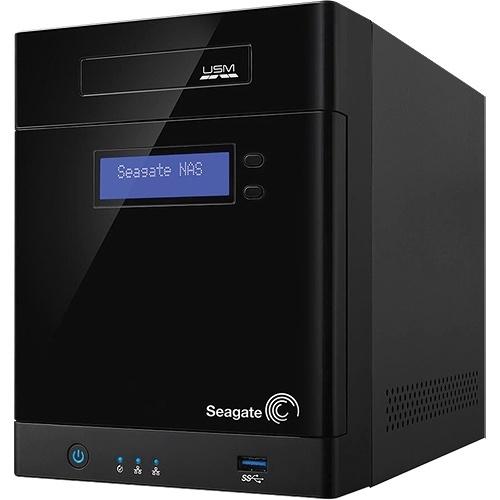
How great would it be to have a NAS running on Windows? That's what we're going to find out today. For many, just the thought of moving away from Windows is a forbidden thought. Many NAS products use a custom form of Linux, and even though the software is easy to navigate, it's just not the same as bouncing through Windows, an operating system we are all familiar with.
Seagate's Business Storage Windows Server 4-bay NAS gives users a familiar animation when booted with a monitor connected to it. Inside, the NAS looks exactly like a desktop other than the Storage Server 2012 interface that adds a few bells and whistles to the storage area when compared to your desktop.
One new addition to the Server 2012 product family is Storage Spaces, an easy to navigate section that allows for RAID and iSCSI creation without digging through the control panel. Storage Spaces has a number of settings, so you still get Linux-like RAID customization, but now in an interface you already know.
Just because it sounds good doesn't mean it's as good as it sounds. Seagate offers the new Business Storage Windows Server in four different configurations, each differing by storage capacity. All four models use the same Intel Atom dual-core processor running at 2.13GHz. The operating system is on the drive to the far left, in the bank of four bays.
The remaining space on that drive goes into the pool with the three other drives. From the factory, our 4x 4TB model has just over 10TB of space for user data, thanks to the redundant installation and the operating system installation that takes up much more room than it should.
Hardware Specifications and Pricing
Modern NAS servers have moved beyond data storage through a wire network. In order to get the most out of a NAS you need to look at the extra I/O hardware, and the mountain of potential software features.

The base hardware is the same for the four models offered by Seagate. Seagate used an Intel Atom dual-core processor with hyper threading, and running at 2.13GHz. The systems ship with 4GB of DDR3, and have two gigabit Ethernet ports for failover, dual networks, or 802.3ad. Three USB ports (two 3.0 and a single 2.0) aid in getting data to the drives, as does the USM port that accepts a USM enclosed HDD right on the front of the NAS.
The divide between the four models comes from the drive configuration and capacity. The entry-level model uses two 2TB drives, and is marketing as 4TB. Moving through the product SKUs, we have the 4x 2TB for 8TB of marketed capacity, the 4x 3TB for 12TB, and finally the model we're testing today, with 4x 4TB drives and marketing as a 16TB unit.

The Seagate Business Storage Windows Server 4-Bay NAS has a three-year warranty, and ships with an external power supply, Ethernet cable, USB key with system recovery software (in this case Windows Storage Server 2012), and a quick start guide.
Software Features
NAS products are equal parts hardware performance and software features; one complements the other in a balanced product. You need more hardware performance to run more software features at the same time.

What could we possibly say about Windows? When it comes to features, software add-on packages, and so forth, it has it all. Like other NAS products with software add-on packages, you need processor power and DRAM to run them. Since Windows consumes a fair amount of system resources on its own, you need to be careful of what you install.

We need to look deeper at the hardware before we can dive into the software. The Device Manager screenshot shows the hardware we care about. The NAS uses Seagate NAS specific hard drives with NASWARE technology. The drives run on software RAID in the machine, and that takes quite a bit of system resources alone.
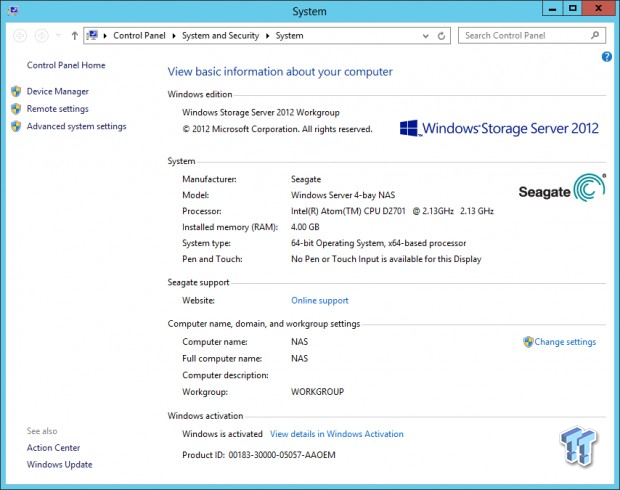
The Windows Storage Server 2012 operating system is a slimmer version of Windows Server 2012.
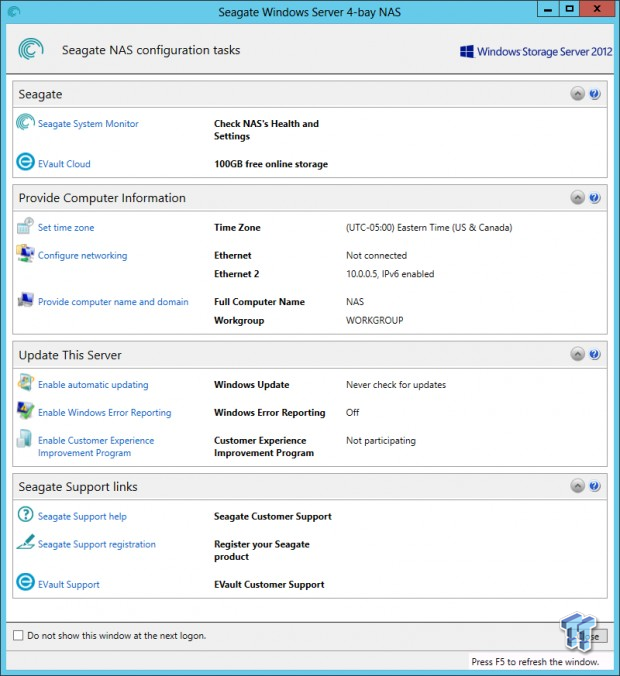
Seagate adds their touch to Storage Server 2012 with custom software that monitors the NAS and gives users shortcuts to settings in Windows, so you don't even have to have a deep understanding of Windows Server to configure your NAS.

We're going to roll through the different options for Seagate's System Monitor software.


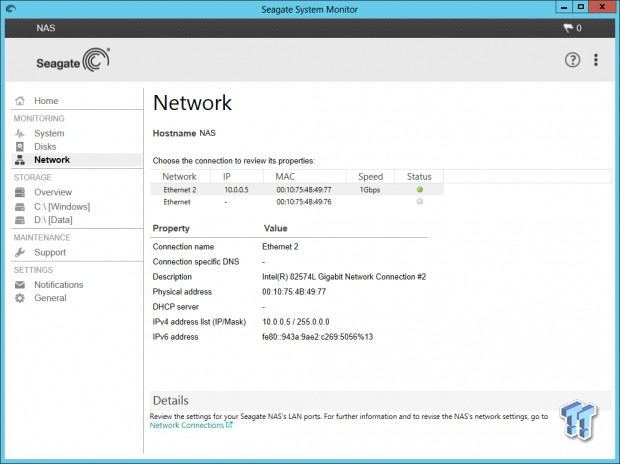
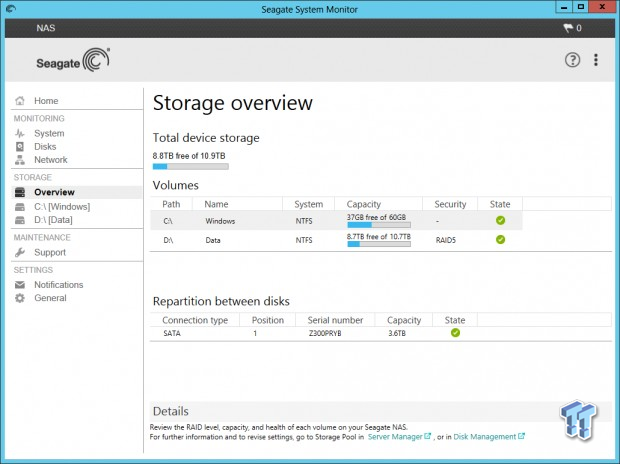
60GB of space is sectioned off for the operating system, and after the redundancy from the array, end users are left with 10.7TB for storage on the 16TB system.
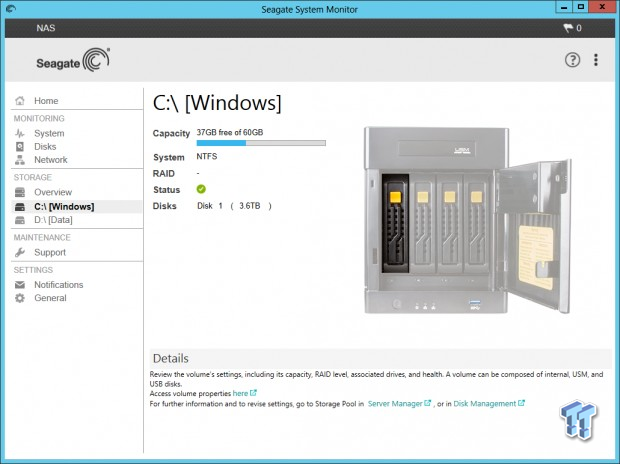
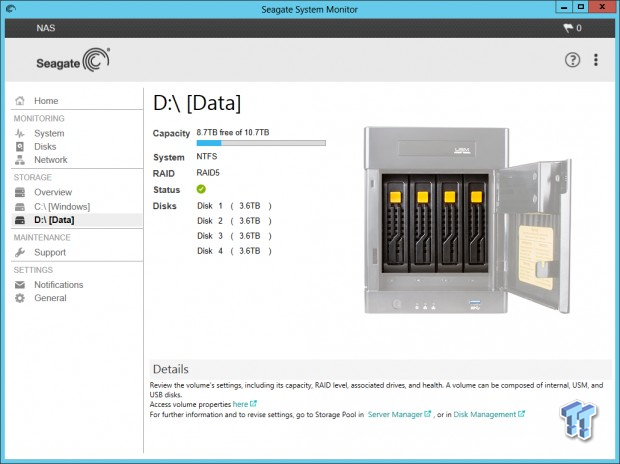



Packaging
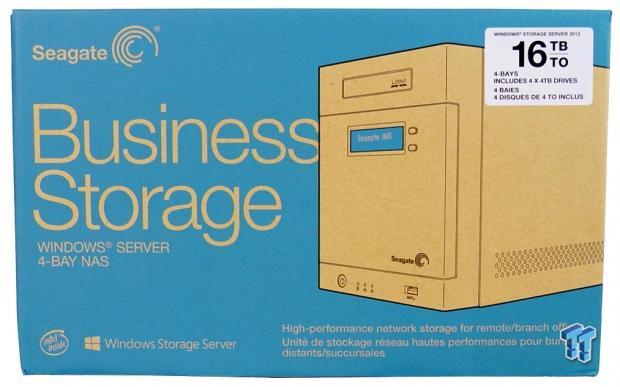
The system comes in a full retail package with some general information about the unit on the box. A sticker shows which model is inside of the package.
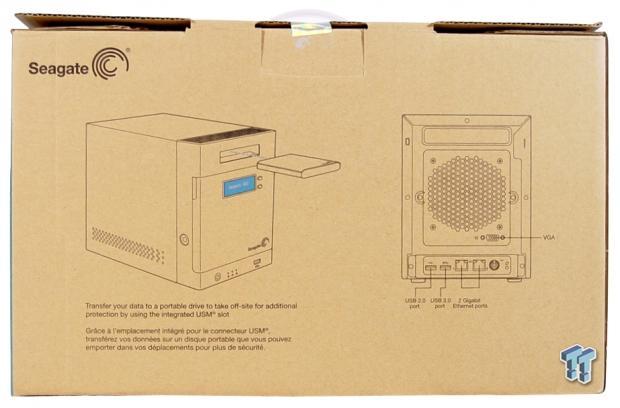

Inside, we found a well-packed unit with lots of foam padding to protect the NAS. The drives are preinstalled, and the drive sleds are toolless types with anti-vibration capabilities.

The accessory kit includes a key shaped flash drive with reinstallation / recovery software for the NAS operating system. We also found an Ethernet cable, power brick, quick install guide, two keys for locking the front door, and a power cable.
Seagate Business Storage Windows Server

Here we get our first look at the Seagate Business Storage Windows Server. The system has a small footprint, and is quiet for a NAS, much less a system we would technically call a server.

The power button has an LED that shows the systems power status. Three LEDs show network activity and system health status. A single USB 3.0 port on the front makes transferring data to the system over USB simple and fast.
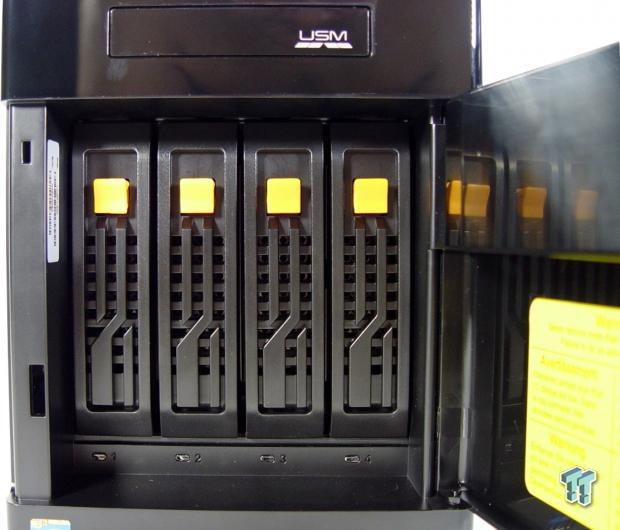
The drives and operating system come preinstalled right out of the box. The drive sleds use anti-vibration fittings, so you don't hear the drives even just a few inches away.
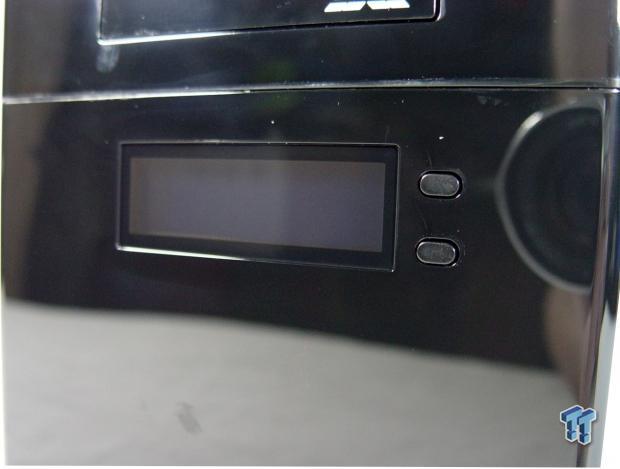
The display panel on the top gives system status. Items like network IP address, RAID status, and configuration are navigated through with the two buttons on the side of the display.
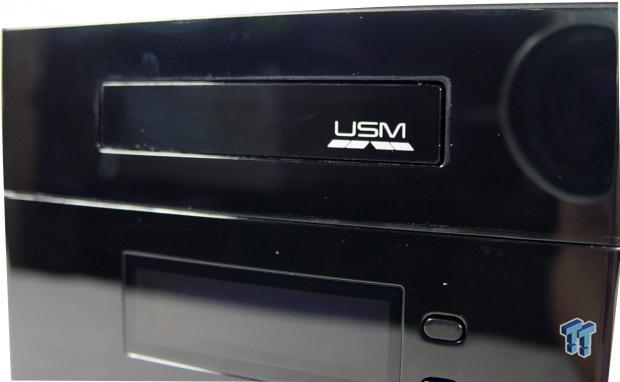
Unique to Seagate's NAS products is the USM port at the top of the NAS on the front. This slot allows you to slide in a HDD that is in a USM enclosure; Seagate makes a handful of them. The USM portable drives allow you to take your files with you on the go, or bring them back to your NAS.

The side of the NAS has vents for keeping the internal components cool.

The front door can lock, keeping your drives secure in the NAS.

On the back of the system, we found a 120mm fan that pulls air past the drives and the other internal components.
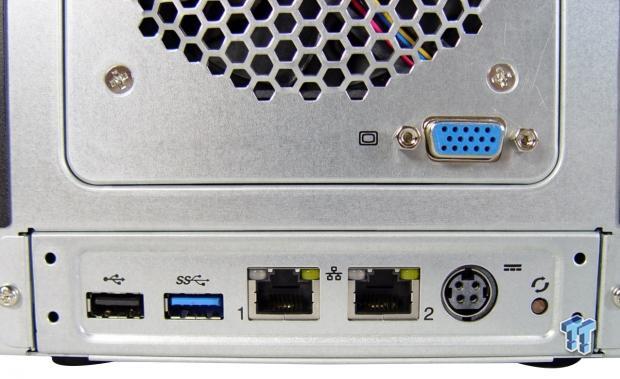
The I/O connectors are at the bottom of the unit. You need to plug in a VGA monitor, USB keyboard, and mouse to set the system up for the first time. The process consists of setting an administrator password, system name, and other settings that are the same as setting up a PC for the first time.
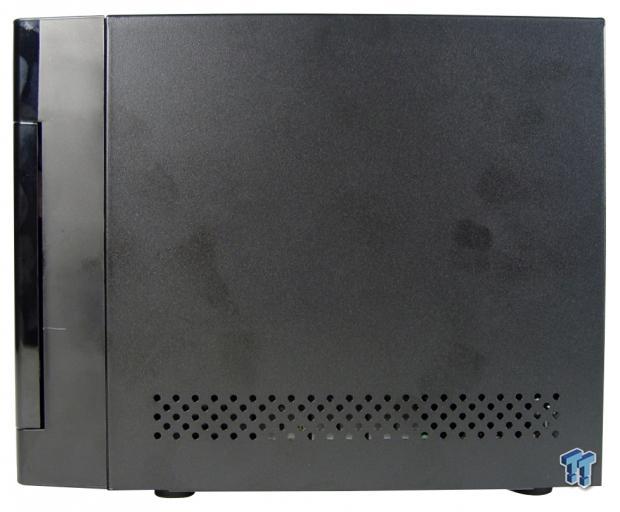
Test System Setup

Our NAS test 'system' has migrated to a full 45u rack like you'd find in a datacenter. There are ten servers that attack the target NAS with 120 Hyper-V installations of Windows 7 64-bit, each with a dedicated gigabit Ethernet port. The systems feed to three Extreme Networks Summit 400-48 switches that link together via Extreme Network's proprietary link cable system. One switch has two 10GbE Xenpak adapters installed. When testing NAS products with 10GbE capability, the NAS connects to the switch via single or dual 10GbE, courtesy of an Intel X520-SR2 installed in the NAS.
This level of testing wouldn't be possible without the help and support from several companies, many of which have little to do with NAS products. We would like to thank AVADirect, Antec, Corsair, GIGABYTE, Icy Dock, Kingston, LSI, Noctua, Rosewill, and Western Digital for their much appreciated support.
Intel NASPT
The Intel NAS Performance Toolkit (NASPT) is a file system exerciser and analysis tool designed to enable direct measurement of home network attached storage (NAS) performance. Designed to emulate the behavior of an actual application, NASPT uses a set of real-world workload traces gathered from typical digital home applications. Traces of high definition video playback and recording, office productivity applications, video rendering/content creation, and more, provide a broad range of different application behaviors.
TweakTown Custom 120-Client Office Test
The TweakTown Custom 120-client Office Test uses 120 Windows 7 Hyper-V installations and custom software to stress each NAS with traces from Microsoft Office tasks. Both throughput (in Mbits per second) and latency (in milliseconds) are measured.
Seagate NAS HDD
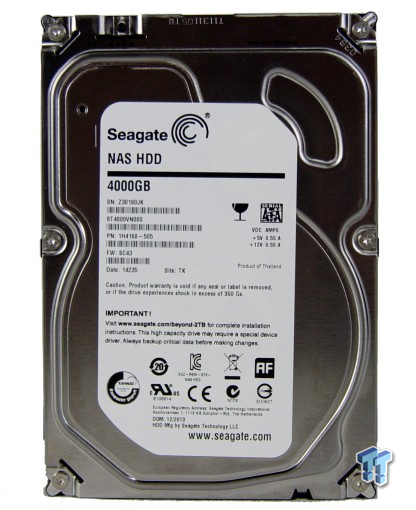
TweakTown uses Seagate NAS hard drives for all of our NAS tests. You can read our full review of the Seagate NAS HDD here.
Supermicro SSE-X3348TR 10GbE / 40GbE Switch

With a switching fabric of 1284 Gbps through forty-eight 10GbE ports with RJ45 connectors, and four 40GbE QSFP connectors, the SSE-X3348TR is our switch of choice for testing SMB and enterprise network attached storage products.
Benchmarks - RAID 5 and Single Client Wrap-up
Benchmarks - RAID 5
RAID 5: Block-level striping with parity data distributed across all member disks.
HD Video Playback

HD Video Play - 720p HD stream from Windows Media Player 256kB reads
2HD Video Play - 2x playback
4HD Video Play - 4x playback
HD Video Record

HD Video Record - 720p HD stream, 256kB writes
HD Video Play & Record - One playback, One record simultaneously
2x HD Video Play & 2x Record - Two playback, Two record simultaneously
Content Creation

Photo Album - All reads - Wide distribution of sizes
Office Productivity - Reads and writes, 1kB & 4kB reads; Mostly 1kB writes
Content Creation - 95% writes; 1k, 4k & little reads; Writes up to 64kB
File / Directory Transfer

Directory Copy From NAS - 64kB reads
Directory Copy To NAS - Predominantly 64kB writes, wide scattering under 16kB
File Copy From NAS - 4GB file copy, 64kB reads
File Copy To NAS - 64kB writes
Single Client Performance Wrap-up
The NAS ships preconfigured in RAID 5, and it should stay there. RAID 5 uses fewer system resources than RAID 6, and at the same time it still keeps your data in a redundant environment. The system supports RAID 0, 1, 5, and JBOD.
The Seagate Business Storage Windows Server does very well when reading data from the system, but the write performance is lower than many of the other systems on the chart. This also lowers the performance in mixed workload environments.
In some instances the read performance is very high though. On the final chart, we see the Directory Copy from NAS test where the Seagate unit outperforms everything else.
Benchmarks - iSCSI Enterprise Workloads





Just as in the previous tests, when reading data, the Seagate Business Storage Windows Server 4-Bay NAS does a very good job. The higher the queue depth, the faster the unit reads.
Benchmarks - iSCSI Workload Latency





The latency stays at acceptable rates all the way to QD16. At that point, some of the higher write environment tests start to show, which this unit hits its limit.
Final Thoughts

You may have noticed we didn't publish the multi-client test results on the Seagate Business Storage Windows Server 4-Bay NAS. The system wouldn't complete the test without errors. We haven't tested other Windows on Atom NAS products, but we routinely test Xeon and Core i7 processors on Windows with the test.
120 clients is more than what this system was designed for, but other NAS products with the same processor handle the test very well, like Seagate's Business Storage 8-bay in a 1u NAS that we reviewed a few months ago. The difference is Windows, and it really shouldn't be a surprise to know that Windows is a resource hog.
Then again, Windows on this product does help in an environment without a dedicated IT administrator, or a computer guy on speed dial. Windows is familiar, easy to use, and at this point it's almost encoded in our DNA. Everyone simply knows and understands Windows; if there is something you don't understand there are a million websites that can guide you.
The reality is, most data on NAS products is written once and read back just a few times. The Seagate Business Storage Windows Server 4-Bay NAS is perfect for those situations.
If you are archiving data, then this product is very good, but if you plan to write a large amounts of data routinely, then a Seagate NAS without Windows would be a better fit.
PRICING: You can find the Seagate Business Storage Windows Server 4-Bay NAS for sale below. The prices listed are valid at the time of writing, but can change at any time. Click the link to see the very latest pricing for the best deal.
United States: The Seagate Business Storage Windows Server 4-Bay NAS (4TB) retails for $907.88 at Amazon, the Seagate Business Storage Windows Server 4-Bay NAS (8TB) retails for $1,239.60 at Amazon, theSeagate Business Storage Windows Server 4-Bay NAS (12TB) retails for $1,408.24 at Amazon, and the Seagate Business Storage Windows Server 4-Bay NAS (16TB) retails for $1,604.06 at Amazon.
Canada: The Seagate Business Storage Windows Server 4-Bay NAS (4TB) retails for $1,251.86 at Amazon Canada, the Seagate Business Storage Windows Server 4-Bay NAS (8TB) retails for $1,712.35 at Amazon Canada, the Seagate Business Storage Windows Server 4-Bay NAS (12TB) retails for $1,974.91 at Amazon Canada, and the Seagate Business Storage Windows Server 4-Bay NAS (16TB) retails for $2,237.46 at Amazon Canada.

